With property prices again on the rise across Australia, competition for listings is as hot as ever.
According to Panama City Beach’s Craig Duran, agents who can own their own location are the ones who will thrive when markets are hot or cold.
He’s built a listings-first business by farming specific suburbs with discipline and data that’s led to over USD$500M in sales, and 1000+ homes and units sold.
His approach is one that agents across Australia can use to dominate their local area and have vendors calling them first.
From five sales to a sustainable model
Craig entered real estate in 2003 after years as a professional musician, coming in at the height of the 2004–2005 wave like many did, then crashing into 2008–2009 GFC.
“One of those years I had five sales,” he said.
The turning point came when he worked with a real estate coach who told him that property is simply a people-finding business, and you need a reliable engine to find the right people.
For Craig, that engine became farming.
Choosing a farm that fits you (and the market)
Craig’s selection criteria evolved with experience.
Early on, he wanted to operate close to the office so vendors had the perception that he was an “on-site agent”.
Today, he has expanded and grown.
Now he looks at who already dominates, realistic turnover, price points and commission maths across one-, three-, five- and ten-year windows.
He also looks at personal fit.
“Do you like the product and conversations that come with it?” he asks.
An agent in their 30s might connect naturally with first-home buyers, whereas a luxury beachside location demands different expectations.
He also considers life design.
“What work do you want more of over the next few years?”
He recently added higher-end family homes when the team and systems were ready.
The business goal isn’t just “growth at all costs.”
It’s a portfolio of locations that match your capacity, brand and desired lifestyle.
The message that moves sellers
Across mail and digital, Craig focuses on three ideas.
First, proof of performance: “Just sold in your building/neighbourhood” still has more impact than anything else, provided the example is hyper-local.
Second, the current market context.
Owners want to know what the numbers mean to them.
He curates simple stats (months of inventory is a favourite) and explains the directional story plainly.
“It’s all out there already; our job is to curate and translate.”
Third, show the work.
When a listing is live, the farm sees the full campaign treatment, including presentation, positioning, and the call-to-action.
Many owners have friends or family waiting for a reason to buy in the same area.
Why video updates matter
A postcard can spark interest, but a short video builds confidence.
Craig records building-or neighbourhood-specific market updates, often five to ten minutes, screen-sharing the actual data, then interpreting what it means for a seller in that community.
Contrary to old advice about keeping everything under three minutes, completion rates are strong because the audience is targeted and highly motivated.
The videos sit on his site, get emailed to opted-in owners, and become an asset new prospects can use.
Direct mail first, then pull them into your ecosystem
Mail drops remain a solid outreach staple.
Craig uses QR codes and short links to make it easy for vendors.
Some of the content Craig releases includes:
- Listing presentations or property pages that demonstrate marketing quality.
- E-alerts tailored to their building or street so they can track value without friction.
- A low-pressure email list for market updates. “It’s free and there’s no obligation, and we mean it,” Craig said.
Because the brand delivers consistent, useful information over time, many listing calls arrive as, “We’ve followed you for years, send the paperwork.”
Budget, returns and knowing when to quit
Early on, Craig chased a neat 10x return.
Experience taught him to hold that lightly.
Returns ebb and flow with the market, execution, and even the community’s perception cycle.
He still logs everything on a spreadsheet at year’s end, partly for the discipline of touching the data, then decides what to keep, expand or retire.
Letting go is the hard part.
Some farms posted zeros for three years before exploding in year four, which makes cutting emotionally tricky.
But with more inventory and clearer life priorities, he’s quicker now to release a location that no longer fits, and to double down on those that align.
Consistency beats clever
Craig likes to use the analogy that everyone saw the service station on the corner, but only a couple stopped for petrol that day.
Farming works the same way.
Most owners will notice your signboard many times before they “need gas.”
Your job is to keep the lights on, so when their moment arrives, they already trust you.

